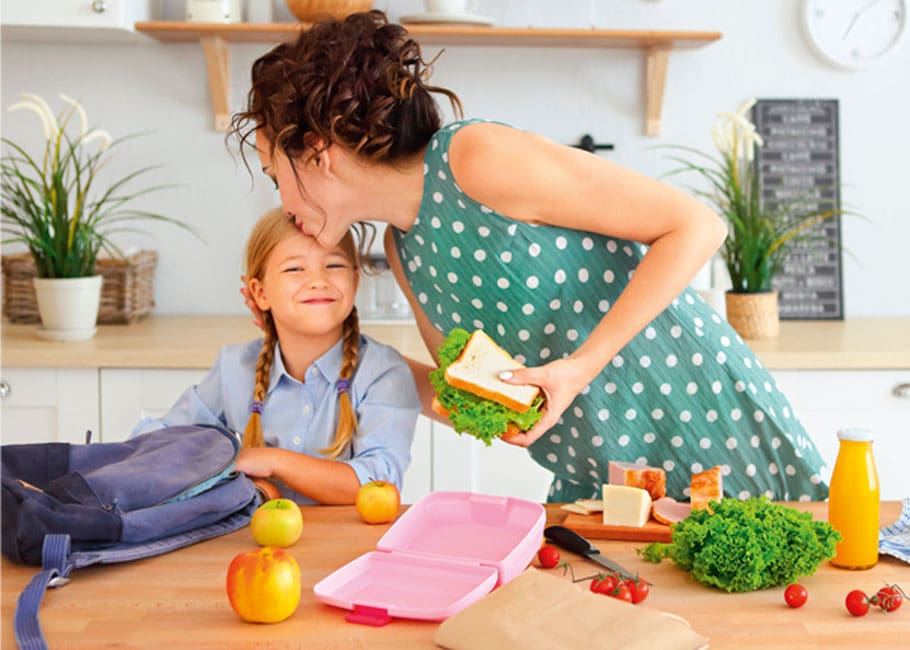
© DASHA PETRENKO / STOCK.ADOBE.COM
Pack it in
When it comes to kids’ school lunches, think outside the box
A new academic year is about to start, and with it a return to the daily task of sending children to school with food that’s healthy, nutritious and, hopefully, won’t arrive back home uneaten. Packing a lunch bag and knowing you might end up chucking half the contents away at the end of the day can feel like a waste of time and money. But growing children need fuel for their bodies and their brains, and this is one task that cannot be abandoned.
“When you think about it, about half of a child’s daily eating opportunities happen at school,” says dietitian and child nutrition expert Charlene Kennedy of Kennedy Nutrition (goodfoodadvice.ca) in Ottawa. “And we know that our children need fuel to function their best from a learning perspective.”
Balance
A balanced lunch should contain carbohydrates, protein, dairy, fruit and/or some vegetables. A tuna sandwich with lettuce and tomato, with a side portion of raw carrot sticks, followed by a cup of yogurt and a sliced plum for dessert ticks all those boxes. But you can consider less traditional packed meals too.
It helps to think outside the box, adds Kennedy: “My best tip would be not to think of foods as meal specific. Think about including ‘breakfast foods,’ for example. Why not try pancakes in a thermos, dried cereal or hard-boiled eggs for lunch?
Age appropriate
It’s also a good idea to take your child’s age into account.
Children ages 5 to 7 will appreciate it if you add a fun element to their meal. Try using cookie cutters to make a simple cheese or ham sandwich star- or heart-shaped (you can freeze the offcuts to make breadcrumbs). Party napkins with cartoon characters or a small toy from home tucked inside can help make lunchtime something a little one will look forward to.
By the time they are ages 8 to 11, youngsters become a bit more adventurous, so try giving them individual quiches, hummus and chopped vegetables, or homemade soup in a thermos that they can dip a sandwich into. Adds Kennedy, “A big hit with kids of all ages are bento-style lunch boxes. They are visually appealing, which is important for kids, and also involve less opening and closing of containers, which can be difficult for small fingers.”
Middle and high school students, meanwhile, might take their lunch break standing around with a group of friends or need to eat quickly because they have a lunchtime study class to get to. You can help by slicing meats and chopping fruit—a squeeze of lemon juice will stop a bag of apple pieces from going brown— and packing food that’s easy to eat on the go. Tortilla wraps are perfect for this age group—there’s no limit to what you can ll them with, and they’re easy to eat standing up.
Get them involved
Getting children involved with the steps that lead to the creation of their packed lunch can help encourage them to eat it. Explore meal ideas together and let them help write up a weekly menu. Including meals that you can prepare the night before will help mornings run more smoothly. Older children can be encouraged to pack their own lunch. You can even trial different meals at home so you both know what’s a winner before it goes to school.
Try not to worry if, despite your best efforts, your child still doesn’t eat their lunch. Says Kennedy, “If lunches are coming home uneaten, have your child start with their lunch as an after-school snack. For many kids, this is the point of the day they are the hungriest. But also, talk with your child to see if you could help make eating lunch at school easier for them. This might be simple things like more finger foods, cutting veggies in smaller pieces or fewer containers.”
Pizza party
Pizza wrap sandwiches are easy to make and work for children of all ages. Simply spray a couple of tortilla wraps with olive oil, place them on a baking tray and bake in a hot oven for five minutes until they’re lightly toasted. Then add pizza sauce, grated mozzarella and your child’s favourite pizza toppings before returning the wraps to the oven and baking for another five minutes until the cheese starts to bubble. After a couple of minutes of cooling time, fold them over into semicircles before cutting into triangles. These can be wrapped in foil and taken to school still warm or prepared the night before and eaten cold.—RH
Hot and cold
A frozen bottle of juice in your kids’ lunch bags will slowly melt and be ready to drink at lunchtime, while keeping their food nicely chilled. Making sandwiches with frozen bread is another trick that keeps fillings fresh even on warm days. Insulated lunch boxes are great for keeping food warm or, if you add a mini freezer block, safely chilled. A food flask, rinsed first with hot water from the kettle, will keep soup or stew warm for several hours.—RH
Costco Connection: You’ll find all of the ingredients you need to pack age-appropriate lunches, as well as lunch boxes, at Costco warehouses. Grocery Delivery is available at Costco.ca.

